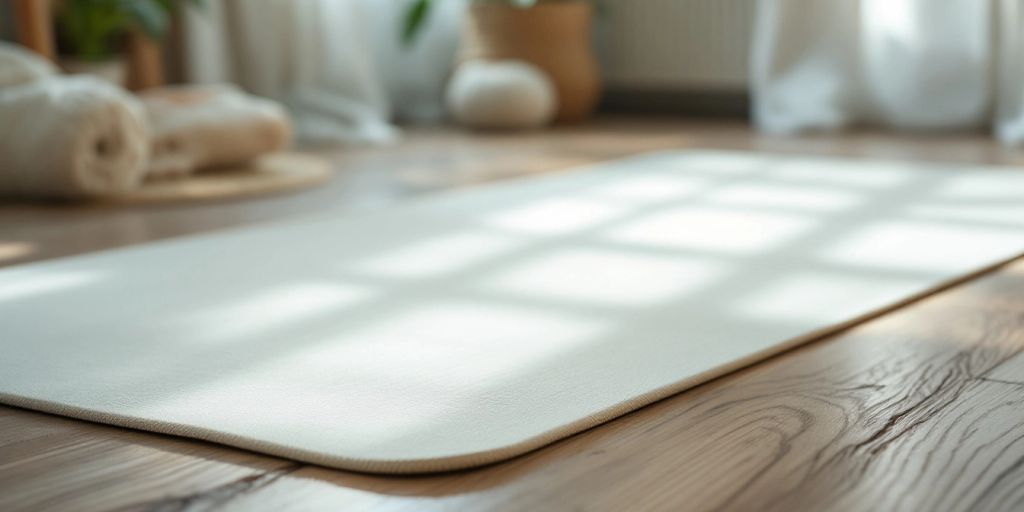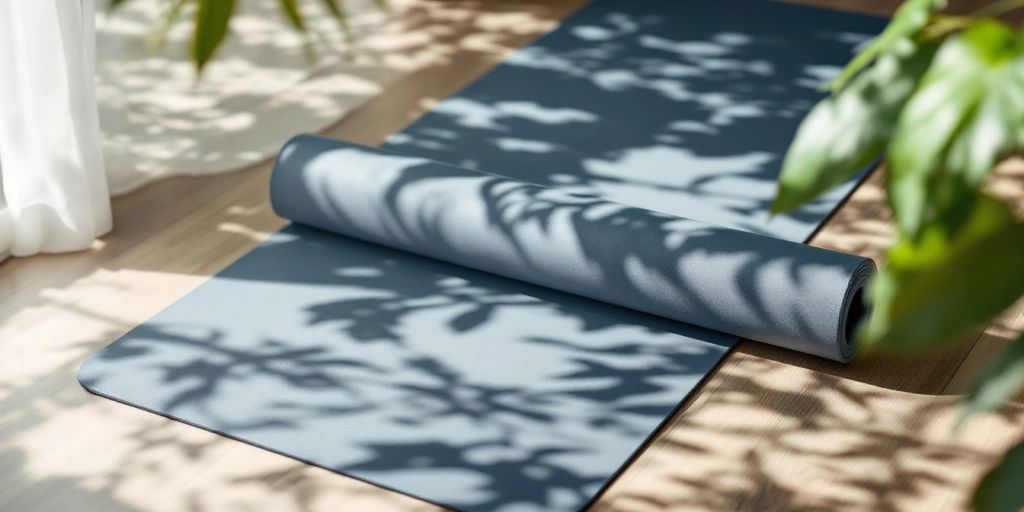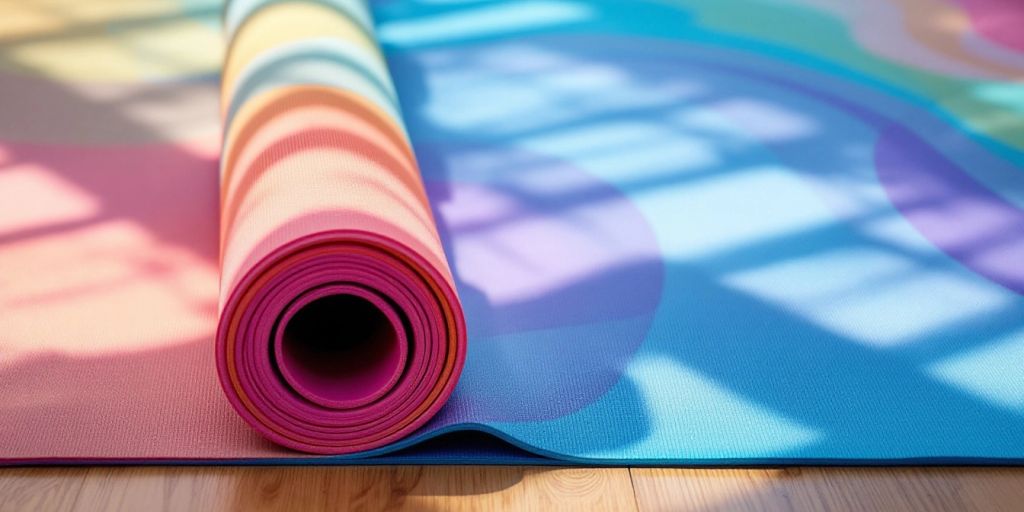
The Ultimate Guide to Choosing the Perfect Off White Yoga Mat for Your Practice
Choosing the right off white yoga mat is crucial for enhancing your yoga practice. This guide will help you understand what to look for in a mat, from material to thickness, ensuring you find one that fits your needs perfectly. Whether you're a beginner or an experienced yogi, the right mat can make all the difference in your comfort and performance during practice.
Key Takeaways
- An off white yoga mat can create a calm and peaceful atmosphere for your practice.
- Material matters; eco-friendly options like natural rubber and cork are great choices.
- Thickness affects comfort; thicker mats provide more cushioning, while thinner ones offer better stability.
- Look for non-slip features to ensure safety during your practice, especially in hot yoga.
- Consider portability and maintenance to keep your mat in good condition for longer.
Understanding the Importance of an Off White Yoga Mat
When it comes to yoga, the right mat can make a big difference. An off white yoga mat not only looks great but also offers several benefits that can enhance your practice. Here’s why choosing an off white mat is important:
Benefits of Using an Off White Yoga Mat
- Clarity and Calmness: The color white is often associated with clarity. An off white mat can help create a peaceful environment, allowing you to focus better during your practice.
- Hygienic Choice: Light colors can show dirt, prompting you to keep your mat clean. This ensures a more hygienic practice space.
- Versatile Aesthetic: An off white mat can match various styles and settings, making it a stylish choice for any yogi.
How Color Affects Your Yoga Practice
The color of your yoga mat can influence your mood and focus. An off white mat can:
- Promote a sense of calm and freshness.
- Help clear your mind of unnecessary thoughts, allowing for a more centered practice.
- Create a serene atmosphere that enhances your overall experience.
Psychological Impact of Off White in Yoga
Using an off white mat can have a positive psychological effect:
- Increased Focus: The soothing color can help you concentrate better on your poses.
- Emotional Balance: It can evoke feelings of peace and tranquility, which are essential for a successful yoga session.
- Mindfulness: Practicing on a mat that promotes clarity can encourage mindfulness and deeper connection to your practice.
An off white yoga mat is not just a tool; it’s a companion that supports your journey towards clarity and peace in your practice.
In summary, choosing an off white yoga mat can significantly enhance your yoga experience by providing a calming and clean environment, promoting focus, and supporting your overall well-being.
Choosing the Right Material for Your Off White Yoga Mat

When it comes to selecting the right material for your off white yoga mat, there are several options to consider. Each material has its own unique features that can enhance your practice. Choosing the right material can greatly impact your comfort and performance.
Exploring Eco-Friendly Materials
- Natural Rubber: This is a great choice for those who want an eco-friendly option. It provides excellent grip and is biodegradable.
- Cork: Known for its antimicrobial properties, cork mats offer a natural feel and improve grip when wet.
- Jute: Jute mats are durable and provide a good grip, making them suitable for various yoga styles.
Comparing PVC, TPE, and Natural Rubber
| Material | Grip Quality | Eco-Friendliness | Price Range |
|---|---|---|---|
| PVC | Good | Low | Low |
| TPE | Very Good | Medium | Medium |
| Natural Rubber | Excellent | High | High |
Pros and Cons of Cork and Jute Mats
- Cork Mats:
- Pros: Eco-friendly, good grip, antimicrobial.
- Cons: Heavier, may require more care.
- Jute Mats:
- Pros: Durable, good grip, natural material.
- Cons: Less cushioning compared to other materials.
Choosing the right material for your yoga mat is essential for a comfortable and effective practice. Consider your personal needs and preferences when making your choice.
Finding the Perfect Thickness and Cushioning
Benefits of Thin vs. Thick Mats
When choosing a yoga mat, thickness plays a crucial role in your comfort and support. Here’s a quick breakdown:
- Thin Mats (1–3mm): Great for stability and grip, ideal for practices where balance is key.
- Medium Thickness Mats (4–5mm): Offers a good mix of cushioning and stability, suitable for various yoga styles.
- Thick Mats (6mm and above): Provides extra cushioning, perfect for sensitive joints or restorative practices. For maximum thickness, opt for a mat of at least 8mm.
How Thickness Affects Your Practice
The thickness of your mat can change how you feel during your practice:
- Stability: Thinner mats keep you closer to the ground, enhancing balance.
- Cushioning: Thicker mats are more comfortable for poses that put pressure on your knees and joints.
- Portability: Thinner mats are lighter and easier to carry, making them great for travel.
Choosing the Right Cushioning for Joint Support
Cushioning is essential for protecting your joints. Here are some tips:
- Consider Your Practice Style: If you do restorative yoga, a thicker mat may be better.
- Test Different Mats: Try out various thicknesses to see what feels best for you.
- Look for Quality: Higher-quality mats often provide better cushioning and durability.
Remember, the right thickness and cushioning can greatly enhance your yoga experience, making it more enjoyable and supportive!
Ensuring Non-Slip Features and Grip
Importance of Traction in Yoga Mats
When practicing yoga, having a non-slip mat is crucial. It helps you maintain your balance and focus, especially during challenging poses. A good grip allows you to concentrate on your movements without worrying about slipping.
Exploring Textured and Sticky Surfaces
Different mats offer various textures that enhance grip. Here are some common types:
- PVC Mats: Known for their durability and excellent floor grip, but can become slippery when wet.
- TPE Mats: These are eco-friendly and provide decent traction, though they may not be as durable as PVC.
- Natural Rubber Mats: They offer great grip and are biodegradable, making them a popular choice for eco-conscious yogis.
- Cork Mats: They improve grip as you sweat, but may require more care to maintain their quality.
| Material Type | Grip Level | Eco-Friendly | Durability |
|---|---|---|---|
| PVC | High | No | High |
| TPE | Moderate | Yes | Moderate |
| Natural Rubber | High | Yes | Moderate |
| Cork | Moderate | Yes | Low |
Best Mats for Hot Yoga and Sweaty Sessions
For hot yoga or intense sessions, consider mats that excel in moisture absorption. Here are some top picks:
- Plyopic Ultra-Grip Pro Yoga Mat: This mat is known for its extreme non-slip features, keeping your hands in place even during sweaty sessions.
- Yogi Bare Paws Mat: Offers excellent grip and cushioning, perfect for hot yoga.
- Liforme Mat: Biodegradable and non-toxic, it provides a strong grip that enhances your practice.
A non-slip mat is essential for a safe and effective yoga practice. It allows you to focus on your poses without the fear of slipping, enhancing your overall experience.
Portability and Maintenance of Your Off White Yoga Mat

When it comes to yoga mats, portability and maintenance are key factors to consider. An off white yoga mat can be a beautiful addition to your practice, but it also needs to be easy to carry and care for.
Lightweight Mats for Travel
- Look for mats that weigh less than 3 pounds. This makes them easy to carry to class or on trips.
- Consider mats that can be rolled up tightly for compact storage.
- Some mats come with carrying straps or bags, which can be very handy.
Easy-to-Clean Materials
- Choose mats made from materials that are simple to wipe down, like TPE or natural rubber.
- Avoid mats that absorb too much moisture, as they can develop odors over time.
- Regularly clean your mat after each use to keep it fresh and hygienic.
Storage and Care Tips for Longevity
- Always let your mat dry completely before rolling it up to prevent mildew.
- Store your mat in a cool, dry place away from direct sunlight.
- If your mat is worn out, consider recycling it or repurposing it for other uses, like padding for outdoor activities.
Keeping your mat clean and well-maintained not only extends its life but also enhances your yoga experience. A fresh mat can make your practice more enjoyable and effective.
By focusing on portability and maintenance, you can ensure that your off white yoga mat remains a reliable companion on your yoga journey. Remember, a well-cared-for mat is essential for a great practice!
Evaluating Size and Length for Your Needs
Standard vs. Extra Long Mats
When choosing a yoga mat, size matters. Most standard mats are about 68 to 72 inches long and 24 inches wide. If you are taller or prefer more space, consider an extra-long mat, which can be around 78 inches or more. Here’s a quick comparison:
| Type of Mat | Length (inches) | Width (inches) |
|---|---|---|
| Standard | 68-72 | 24 |
| Extra Long | 78+ | 24 |
Choosing the Right Width for Comfort
The width of your mat can also affect your practice. A wider mat can provide more room for your poses, especially in side stretches. Here are some options:
- Standard Width (24 inches): Good for most practices.
- Wider Mats (26-30 inches): Better for those who need extra space.
Customizing Your Mat Size
If you have specific needs, you might want to customize your mat size. Some brands offer options to create a mat that fits your height and practice style. This can be especially helpful for:
- Taller individuals who need more length.
- Yogis who prefer a wider base for stability.
- Those who want a unique design that reflects their personality.
Remember, the right size mat can enhance your practice and make you feel more comfortable during your sessions. Choose wisely!
Setting a Budget and Making Your Purchase
When it comes to buying an off white yoga mat, setting a budget is crucial. Yoga mats can vary widely in price, so knowing how much you want to spend will help narrow down your options. Here are some key points to consider:
Balancing Quality and Cost
- Quality Matters: A good mat can enhance your practice, so don’t just go for the cheapest option.
- Price Range: Expect to pay anywhere from $20 to $100 for a decent mat.
- Long-Term Investment: Sometimes spending a bit more upfront can save you money in the long run if the mat lasts longer.
Understanding Price Differences
| Material Type | Price Range | Durability |
|---|---|---|
| PVC | $20 - $50 | Moderate |
| TPE | $30 - $70 | Good |
| Natural Rubber | $40 - $100 | Excellent |
| Cork and Jute | $50 - $100 | Very Good |
Where to Buy Your Off White Yoga Mat
- Local Stores: Check out local fitness or yoga stores for hands-on experience.
- Online Retailers: Websites often have a wider selection and better deals.
- Second-Hand Options: Consider gently used mats for a more budget-friendly choice.
Remember, the right mat can make a big difference in your practice. Take your time to find one that fits your needs and budget!
Final Thoughts on Choosing Your Ideal Off White Yoga Mat
In conclusion, picking the right off white yoga mat is key to enjoying your yoga practice. Remember to think about your yoga style, the material of the mat, and how thick you want it to be. A good mat can make you feel more comfortable and help you stay safe while you practice. Don't forget to read reviews and test out different mats if you can. The perfect mat is out there waiting for you, and it will make your yoga journey even better. Happy practicing!
Frequently Asked Questions
Why should I choose an off white yoga mat?
An off white yoga mat is calming and can help create a peaceful atmosphere for your practice. It also matches well with many styles and colors.
What material is best for an off white yoga mat?
The best materials for an off white yoga mat include natural rubber, TPE, and cork. These materials offer good grip and are eco-friendly.
How thick should my yoga mat be?
The thickness of your yoga mat depends on your comfort. Thicker mats (6mm or more) are better for joint support, while thinner mats (3-4mm) offer more stability.
Can I use my yoga mat for hot yoga?
Yes, but make sure your mat has good moisture absorption and grip. Mats made from rubber or microfiber work best for hot yoga.
How do I clean my yoga mat?
To clean your yoga mat, use a gentle soap and water solution. Wipe it down with a cloth and let it air dry. Avoid harsh chemicals.
Where can I buy a quality off white yoga mat?
You can find quality off white yoga mats at yoga studios, sporting goods stores, or online retailers. Look for customer reviews to help you choose.


